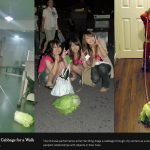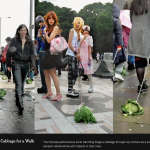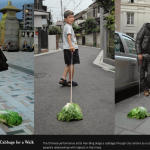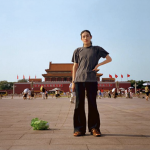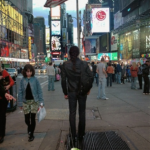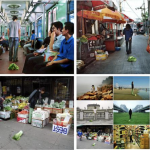“Social intervention performance” is how Chinese artist Han Bing (b. in 1974 in Jiangsu, lives in Beijing) describes his Walking the Cabbage series, which he discusses with the New York Times linked video. [credit]
“From Ginza to Times Square, from Tiananmen to the Champs-Elysées, Han Bing and his cabbage have traveled the world. Through his photographic series, Han Bing asks viewers to stop and consider: What do we hurtle towards? And at what cost?
Walking the Cabbage in Tiananmen (2000) features an androgynous figure walking a cabbage in Beijing’s Tiananmen Square. Nothing unusual about that, his easy pose and arm akimbo seems to suggest. The artist behind the work – and in front of the camera – is Chinese artist Han Bing. Han specializes in photography and site-specific performance art in which some of his performances span nearly a decade and cross continental divisions. Walking the Cabbage in Tiananmen is part of one such series of performative photographs. Han produced the Walking the Cabbage series over a period of eight years, from 2000 to 2008.
Walking the Cabbage in Tiananmen is one of the earliest photographs from the series; the journey continues with Han Bing walking the cabbage in the Houhai district of Beijing, Han Bing walking the cabbage in a subway carriage of Beijing (2004), Han Bing cradling his cabbage in Jiangsu Province (2005), Han Bing walking the cabbage in Miami Beach, USA and Chinatown (2007). Han Bing walks and walks, posing with his cabbage as if oblivious to the gawking crowds and ever-present camera.
According to the artist, his intention in making art is for “people to see how much of our daily lives are routines that we’ve blindly absorbed.” And in this work, Han does just that through his subtle manipulation of hackneyed imagery which raises important questions about contemporary Chinese social norms.
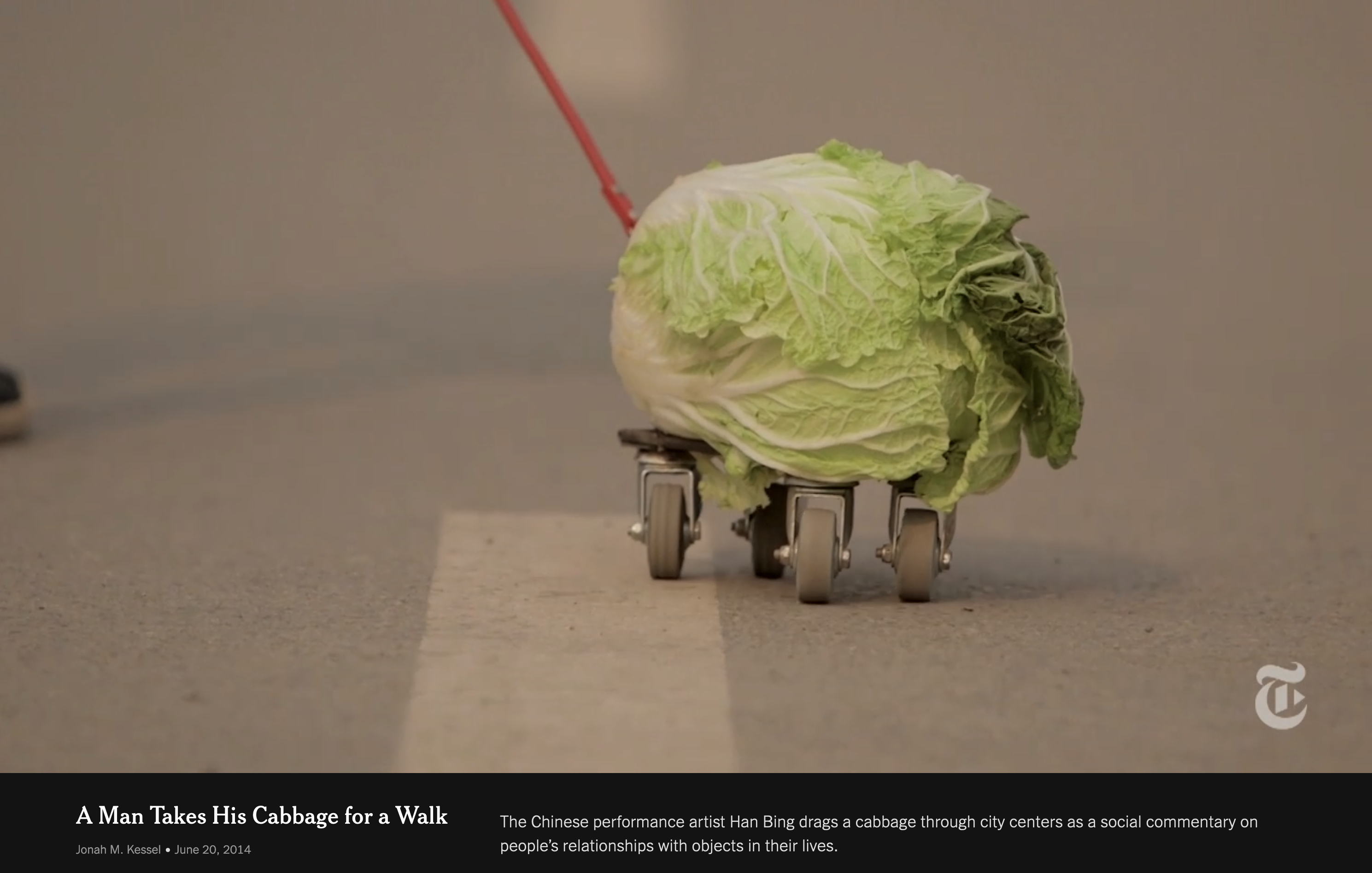
Walking the Cabbage in Tiananmen is a particularly ambitious undertaking. In it, Han takes on one of the most iconic of symbols of China – the Forbidden City. To the everyday Chinese, the Forbidden City is a symbol of imperial power; this frontal view from Tiananmen Square is also a place of great historical significance in modern China. Here on the first of October 1949, Mao Zedong proclaimed the founding of the People’s Republic of China, reportedly declaring that “The Chinese People have Stood Up.”
Today, the site’s political and historical significance is overshadowed by its new identity as the necessary photo-op for seemingly every tourist who passes through Beijing. In this sense, Han Bing’s photo is so obvious as to be banal.
But all is not as it seems, for the composition demands viewers to ask questions. What is the artist doing with a cabbage in the midst of Tiananmen Square? And here lies the creative brilliance of the composition. Han ignores a half-century of art history discourse as he seemingly fails to realize that his is an age where iconography has become decidedly passé; this series of works employ ordinary symbols to create meaning.
The Cabbage is a particular favorite in Han’s oeuvre. According to Han’s website, the Chinese Cabbage is “…a quintessentially Chinese symbol of sustenance and comfort for poor Chinese turned upside down. If a full stock of cabbage for the winter was once a symbol of material well-being in China, nowadays the nouveau riche have cast aside modest (monotonous) cabbage in favor of ostentatious gluttony in fancy restaurants where waste signifies status…Yet, for the poor and struggling, the realities of cabbage as a subsistence bottom line have not changed—what’s changed is the value structure that dictates what—and who—is valuable or worthless in Chinese society.”
- Han Bing, Walking the Cabbage in Tiananmen, Walking the Cabage 2000- 2009 series C-print edition of 12 50 x 75 cm | © Han Bing Art.
- Han Bing, Walking the Cabbage Across the USA: NYC 2007
- Han Bing,Walking the Cabbage series | © Han Bing Art.
Omit the cabbage and the picture becomes almost ordinary as the requisite tourist picture in front of Tiananmen.
Knowing the iconographic significance of this site, Han Bing plays with the imagery through his composition. From the low-angle view of the camera, Han Bing dominates the composition; he literally stands head and shoulder above Tiananmen’s great wall.
This striking view point lends a monumentality to Han and his cabbage that the camera emphasizes by focusing on the foreground and blurring the background. This viewpoint brings to mind the imagery of old Communist posters depicting the exuberant triumph of the proletariat. And if one so chooses, one could read into the picture a political statement.
With his casual stance, Han lulls the viewer into forgetting the meticulous framing of the image; he sneakily causes us to forget what is missing from this iconic view — the framed portrait of Chairman Mao. But the image could just be another tourist photo, where the tourist in his eagerness to show friends that he’s made it to Tiananmen, inadvertently blocks out the nation’s most famous face. Make of that what you will, the image suggests.
Perhaps politics is indeed a distraction. Although Chinese art in the West is often viewed politically, with Ai Weiwei being the poster child of political criticism, Han’s works seek instead to confront the problems faced by ordinary Chinese people in the march towards modernization and urbanization. In this image, Tiananmen Square becomes a mere backdrop for Han and his cabbage, a suitable starting point for his photographic series and his critique of contemporary Chinese values.
Placing the focal point on Han and his cabbage on a leash, Han seeks to address ‘the way our everyday practices serve to constitute ‘normalcy’ and our identities are often constituted by the act of claiming objects as our possessions’. The modest cabbage on a leash “offers a visual interrogation of contemporary social values.” Once a symbol of well-being and a full stomach, it has now been discarded for bigger, better, more expensive, more impressive and more frivolous thrills. And those will, in turn, be cast off for something better.” [credit]
